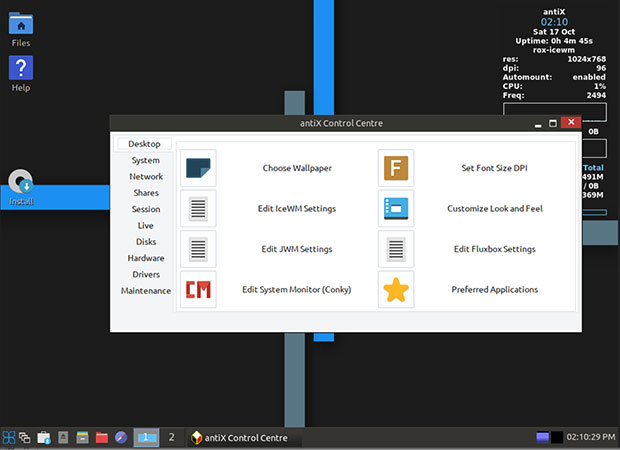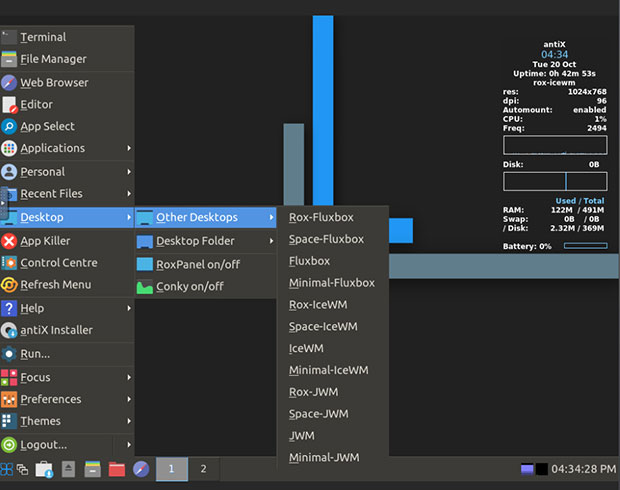The antiX distro offers a solid operating system that many other Linux communities fail to deliver. It is unassuming but reliable and focuses on performance rather than prettiness.
That last element goes a long way to giving users distraction-free computing power. That does not mean antiX is not visually appealing. This distro has a no-nonsense appearance.
Instead of lighting up the background and displaying decorative themes, it provides a plain, mostly dark view that lets you concentrate on the computing tasks at hand. Within this bland screen setting is an array of outstanding Linux applications and computing tools.
Another great design feature is antiX’s ability to make older hardware vibrant and useful again. This handy and innovative approach keeps aging computers fast and active. It is also an energy infuser for new computers.
I started playing around with antiX when looking for something different to keep some older computers out of the trash heap. AntiX runs the extremely lightweight IceWM desktop environment by default. Two other versions are available running either fluxbox or jwm.
Do not confuse antiX Linux with Artix Linux, however. These are two totally different products that have little in common.
Unique Computing Power and Options
The latest version of antiX (19.3), dubbed Manolis Glezos, was released on Oct. 17. This is a fast and functional operating system that is easy to install. It is based on Debian Buster for Intel-AMD x86 compatible systems and is fully systemd-free.
This latest upgrade comes with improvements to SysV and Runit series. It runs both 32-bit and 64-bit architecture with sysvinit or runit. Having a choice of these two under-the-hood startup components will not concern new users. But seasoned Linux users will no doubt like having this choice.
AntiX’s 32-bit edition has a non-PAE kernel (Physical Address Extension) that lets 32-bit systems access 4 GB RAM. This is one of the reasons antiX is an excellent choice to keep older hardware running with a modern and powerful operating system. This series has a hefty kernel, which allows it to support old and new hardware and the inclusion of more firmware for all three of its editions: full, base, and core.

This distro runs on most computers, ranging from 256 MB old PIII systems with preconfigured swaps to the latest powerful boxes. You need at least 256 MB RAM, and the installer needs a minimum 2.7 GB hard disk size.
A really nice multifunctional use in running antiX is its capabilities as a fast-booting rescue CD, or “live” operating system that runs on a USB stick, with or without persistent file storage. You also can partially install it to your computer’s hard drive in a ‘frugal’ configuration. The live session remaster tool lets you customize your own version or create ‘snapshots’ of an installed system for emergency reinstallations without having to start from scratch.
Lightweight, Not Underpowered
AntiX was initially released in 2007 as a lightweight distro based on MEPIS. That “old-time” small footprint appearance remains today by design. AntiX has a distinctly unique look. In part, that look is highly functional. Its design maximizes low system resources so it can run on older machines.
Running antiX on newer machines with souped-up RAM and modern video cards do little to spruce up its appearance. In fact, I consider antiX ugly in comparison with most other Linux desktop appearances. But it is highly functional. That is what matters most. So you must be willing to accept that tradeoff.
Normally, in less lightweight Linux OSes, a full-fledged desktop environment like Xfce or GNOME manages overall desktop display functions with a separate windows manager server within. Instead, antiX uses a windows manager without the larger desktop shell.
This design makes it ideal for limiting the number of resources consumed in legacy computers. AntiX Linux’s design is packed with powerful applications that cover every conceivable computing task with multiple options.
Downloadable Choices
As noted above, antiX runs on windows managers rather than a bona fide desktop environment. For most purposes, that is a distinction without a difference.
Although you only have two virtual workspaces, you can move applications between the two. You can run windows full screen or reduced size to share multiple windows on the same screen.
Animations and sound effects are not a part of the windows manager landscape. You also have ample system settings to personalize how you work in antiX. The control center and numerous settings panels let you put your own personal appearance to the desktop display and functionality.
One of those menu controls lets you switch among the built-in window managers on the fly. The ability to quickly change the “desktop” display and the styles and background images make antiX more than a one-view desktop machine.

For a typical user, the best option is to download antiX-full (c1.2GB). It contains four windows managers: IceWM (default), Fluxbox, jwm and herbstluftwm. Additional windows manager variations of these four are included.
- AntiX-base (770MB) is more limited with just four windows managers. You get IceWM (default), Fluxbox, jwm and herbstluftwm.
- AntiX-core (470MB) lacks X but has a CLI-installer without UEFI support nor encryption. It should support most wireless cards.
- AntiX-net (170MB) has the same missing items as shown in core. It comes with just enough to get you connected (wired) and ready to build.
It also comes with the current full LibreOffice suite.
Using It
One of my favorite “desktop” features is the ability to have multiple ways of accessing system menus. AntiX has three.
The primary or main menu display pops up with a click on the traditional menu icon at the far right of the bottom panel. The second approach to menu access is right-clicking anywhere on the desktop. The third is a context menu you access by right-clicking on the title bar of an open window.
Right-click on the panel bar at the bottom of the screen to access a variety of display options such as tiling, cascading horizontally or vertically, as well as logging out. The far-right end shows two system monitors and the clock/calendar. The other end of the panel bar has several system icons.
You cannot place application launchers on the panel or on the desktop itself. However, the panel serves as a thumbnail display dock for open windows. Right-click on the thumbnail for a variety of context-specific actions.
The desktop display includes a conky display of several system readouts and the local weather. You can turn the conky display off/on from the system menus.
Bottom Line
One of the more impressive aspects of the bundled software collection is special tools. Especially helpful is a boot repair tool that saves you the hassle of tracking down an alternative to get a broken system up and running again. This often happens on systems configured to dual-boot a variety of OSes. These specialty tools include:
- Bootrepair
- Codecs installer
- Network Assistant
- User Manager
- ddm-mx – install nvidia drivers
- Repo Manager – choose your mirrors for faster downloading
Other included tools are a collection not normally found in standard Linux distributions. Take a look at this list:
- hexchat – GUI chat
- wingrid-antix – turn the stacking window managers into tilers
- connectshares-antix for network shares
- droopy-antix – an easy way to transfer files over the net
- AntiX Control Centre – an easy way to do just about anything!
- streamtuner2 – listen to streaming radio
Another unique software component in antiX is an in-house collection of command line interface (CLI) applications. You launch them from the terminal window.
Suggest a Review
Is there a Linux software application or distro you’d like to suggest for review? Something you love or would like to get to know?
Email your ideas to me, and I’ll consider them for a future column.
And use the Reader Comments feature below to provide your input!























































